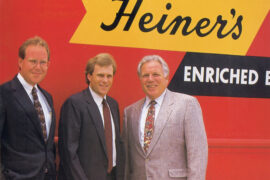Five reasons why Huntington and Charleston must build a new regional airport
By James E. Casto
HQ 42 | SUMMER/AUTUMN 2001
In the golden age of American passenger railroading, the smallest dots on the railroad route maps were called “whistle-stops.” They were so small, with so few passengers, that trains only stopped at them when they were signaled to do so. Once he was signaled, the train’s engineer would acknowledge it with a shrill blast from his whistle. Unsignaled trains would steam right on past without stopping
Today, a number of factors – including airline deregulation and the industry’s switch to a hub-and-spoke route system – have combined to so erode service at Huntington’s Tri-State Airport and Charleston’s Yeager Airport that they are little more than air age whistle-stops.
In 1968, passengers at Tri-State Airport could board a four-engine, 87 passenger Eastern Air Lines Lockheed Electra and be whisked away to New York’s Newark Airport, landing 90 minutes or so later. Gone are the days.
Eastern Air Lines vanished into aviation history long ago, a victim of the merger mania that has swept through the nation’s airline industry. Other airlines, too, have come and gone at Tri-State. The airport saw the advent of local jet service and then the end of that service. And over the years the number of flights offered has steadily dwindled.
Yes, you can fly from Tri-State to virtually any point on the globe – but only if you’re willing to start your journey by first flying to Pittsburgh, Charlotte or Atlanta via one small aircraft that the airline industry euphemistically calls “commuter aircraft,” but most of us call them “puddle jumpers.” That’s the sum total of the flight schedule at Tri-State. Yeager offers a schedule that’s more extensive than that at Tri-State but only marginally so. This didn’t have to happen.
It could have been averted if Huntington and Charleston had seized their opportunity to build a new regional airport in the 1960s – the “Midway Jetport,” as it was called then. And it still can be reversed, if the two communities can take advantage of the second chance that’s been given us and get behind the current proposal for a new regional airport.
In a January 1992 report to the West Virginia Public Port Authority, a consultant labeled a new regional airport “warranted and feasible.” And after looking at more than 40 possible sites, the Port Authority selected one in Lincoln County, just a few miles south of Interstate 64 and roughly equidistant between Huntington and Charleston.
But today, nearly a decade later, the proposed regional airport still remains under study, a process that’s been needlessly lengthened by lawsuits and other roadblocks that have been thrown up at every opportunity by Yeager Airport, which is fiercely opposed to any new airport.
Although it’s widely seen as favoring a new airport, the Port Authority has yet to call for its construction.
“The Port Authority has never pushed a regional airport,” says Lowell Johnson, assistant secretary for ports in the state Department of Transportation. “We have found in our studies that such a facility breathe new life into the state economy, just as regional airports have done all over the country.”
Johnson was a trusted aide to Bob Wise when Wise was a member of the U.S. House of Representatives. When Wise was elected governor in 2000, he assigned Johnson to the Department of Transportation and put him in charge of riding herd on the thorny airport issue.
On taking office in January, Gov. Bob Wise promised he would make a “build or don’t build” decision on the regional airport by his first anniversary in office. Since then he’s repeatedly said he intends to stick to that timetable and bring a resolution to the heated controversy.
In a sense, the roots of that controversy can be traced to the 1940s and the 1950s and the decisions that saw Tri-State and Yeager each built by slicing away the top of a hill. Granted, those involved may have felt they had no choice. After all, flat land in West Virginia is scarce. But perching each of the two airports on its respective hilltop meant that expanding them would be hugely expensive.
What was then called Kanawha Airport, later re-christened as Yeager, came first. It was dedicated on Nov. 3, 1947. Almost exactly five years later to the day, Tri-State Airport recorded its first landing – a Piedmont Airlines flight – on Nov. 2, 1952. Like Eastern, Piedmont long since has flown off into airline history.
The opening of Tri-State Airport successfully capped a seven-year effort by local government officials, the Huntington Regional Chamber of Commerce and other interested citizens to return regularly scheduled air service. The Huntington area had lost its only air link in 1945, when American Airlines stopped serving Chesapeake Airport, just across the Ohio River from downtown Huntington.

By the late 1960s, however, Huntington city officials and the Chamber of Commerce were looking to the future and advocating construction of a new airport – at a Putnam County location that could serve not only the Huntington area but also Charleston and the Kanawha Valley.
One of the strongest voices raised on behalf of what came to be called the “Midway Jetport” was that of Ken Hechler, who then represented West Virginia in the U.S. House. Combining the passenger traffic from the two cities, Hechler argued, would mean better facilities and more flights and would pave the way for a dramatic expansion of air cargo service to and from our region.
But the proposed new airport had very powerful enemies, including the late U.S. Sen. Jennings Randolph and a number of Charleston political and business leaders. Midway’s supporters picked out a site near Cow Creek in Putnam County, prompting the proposed regional airport’s detractors to derisively dub it “Cow Creek International.”
Randolph’s opposition was particularly telling. A one-time executive with Capital Airlines, he was looked on by many as an aviation expert. And he predicted that the next generation of airliners would be able to take off and land vertically – thus eliminating the need for the long runways envisioned for the new airport. Today, more than 30 years later, a few VTOL – short for “vertical takeoff and landing” – aircraft are used by the military, but not by the airlines.
The FAA eventually endorsed the idea of a new airport, but with an important “catch” – only if the citizens of Huntington and Charleston could come to agreement. That wasn’t to be.
In 1967, Cabell County voters went to the polls and endorsed a $2.5 million bond levy to help pay the local share of the new airport’s cost. Putnam County voters also approved $500,000 in airport bonds. But Kanawha County officials loaded down the ballot there with a total of $9 million in bonds, not just for the airport but for schools, a new courthouse, recreation facilities and a stream revitalization project. Not surprisingly, Kanawha voters said “no.” The outcome might have been very different if Kanawha officials, seeing the new airport as a threat rather than an opportunity, hadn’t deliberately stacked the deck.
At one point in the Midway battle, Huntington businessman R.O. Robertson Jr., who chaired the new airport forces, told the Huntington Rotary Club: “Gentlemen, the name of the game is…adequate air service. We have not had adequate air service in the past…and we believe our chances in the future, without Midway, are either slim or none at all.” Robertson was to prove an all too-accurate prophet.
In 1970, Orin E. Atkins, then the president and CEO of Ashland Oil, placed the proposed Midway Jetport at the top of the list of goals needed if the region was to grow.
And so, not surprisingly, in 1998, when Ashland Inc. left the city of its birth and moved its corporate headquarters to Covington, Kentucky – only minutes from the Cincinnati/Northern Kentucky International Airport – company executives cited the region’s inadequate air service as one of the main reasons for its departure.
There’s every reason to believe that the recent economic history of our region – with its continuing loss of jobs and population – could have been a very different story had Huntington and Charleston combined forces to build a new airport.
Our region has paid, and continues to pay, an enormous price – in lost jobs, lost people and lost opportunity – for our lack of convenient, affordable air service. But we don’t have to keep paying that price. Second chances in life are rare, but we have been given a second chance to build a new regional airport to serve Huntington, Charleston and the region – the very airport we could and should have constructed more than 30 years ago.
A handful of powerful naysayers were successful in keeping the Midway Jetport from becoming a reality then. The unanswered question now is whether the current opponents of a new regional airport again will prevail. We simply can’t afford to let that happen.
You can make a long list of reasons why our region MUST build a new airport. Here are five …
Reason 1. A new airport will mean better air service. Without it, today’s already inadequate service can only get worse.
In the years since the demise of the Midway proposal, Huntington and Charleston have invested millions of dollars in expanding and upgrading Tri State and Yeager instead of taking the logical, common sense step of pooling their passengers and their dollars.
Meanwhile, the nation’s air service has changed dramatically.
As a result of airline deregulation, today many air travelers can fly at bargain prices – but strictly between the nation’s big cities. It’s been suggested that the post-deregulation world is divided into two camps: those cities that are served by low-fare maverick Southwest Airlines and those that aren’t. Certainly, deregulation has been a disaster for small rural states such as West Virginia, where flights are fewer, planes are smaller and fares are higher – often lots higher. Little wonder that these days many air travelers in our region start their trip by getting in their cars and driving to Columbus to take advantage of cheaper fares and better schedules. The airline industry calls this “leakage.” Studies suggest the leakage at Tri-State and Yeager exceeds 50 percent.
Tri-State and Yeager already have lost most of the leisure travel market to Columbus. Now many business travelers, when they have an opportunity to plan in advance, are driving to Columbus to fly.
A 1995 study done for the Port Authority called a new regional airport “the best opportunity for long-term improved air service to the Charleston/Huntington/Eastern Kentucky/Southern Ohio region.”
The logic behind that conclusion is simple: If better facilities and better service are provided, more passengers will use the new airport rather than make that three-hour drive to Columbus.
Yeager’s backers insist that a new airport would mean higher ticket prices, as the airlines would be forced to charge higher fares in order to pay their share of the construction costs. But of the many factors involved in airline ticket pricing, the most important is competition. Lure just one new low-cost carrier to a new regional airport and the cost of tickets will go down, not up. That’s the way competition works.
Reason 2. A new airport will create thousands of new, high- paying jobs.
Studies indicate that building a regional airport would create an estimated 10,000 temporary jobs during the three years of construction, and more than 3,700 permanent jobs once the new airport is completed and opened. Some would be at the airport itself, others would be indirect jobs created by the goods and services the new airport would require. And still more jobs would be generated by industries envisioned on the thousands of acres of adjacent developable land.
Huntington businessman Ned Jones uses the word “jobs” a great deal in explaining his avid support for a new airport. Jones is chairman of the Just In Time Transportation and Development Corporation, a grass-roots group organized to push the new airport plan. The group has been distributing a bumper sticker that reads “JobsPort.”
Jones recalls a public meeting where Kanawha County Commissioner Kent Carper, a Yeager partisan and outspoken foe of any new airport, was asked how many jobs Yeager would create if it extended its runway as it has proposed. Carper’s answer: “zero.”
“That,” says Jones, “clearly sums up the difference in the potential of the two projects: thousands of new jobs versus maintaining the status quo.”
Reason 3. A new airport will enable our region to better compete in the global marketplace.
Our region has much of what new business and industry want: abundant and productive labor, a strategic location (two-thirds of the U.S. population lives within a 500-mile radius), available and affordable electricity, good sites and excellent highway, rail and river transportation.
The “missing link” is the region’s sub-par air service.
Jerry McDonald, president of the Huntington Area Development Council, reports that virtually “every prospect who visits our area comments about our poor air service. These comments are usually directed equally at Yeager and Tri-State.”
Checking his prospect files for 1999 and 2000, McDonald reports that 21 companies, representing more than 2,800 potential new jobs, eliminated our region fromconsideration for new plants or other businesses because of our poor air service.
“The minimal expansion of facilities and services that could occur at either Yeager or Tri-State will not be sufficient to improve air service and allow our region to grow more jobs,” says McDonald. “In order to survive and prosper in the 21st century, we must build a new regional airport that will have the ability to compete with other areas. Like technology and so many other pieces of the business picture, we must keep up or be passed by.”
Jim Purgerson enthusiastically seconds that view. Purgerson is president of the Ashland Alliance, the regional development partnership that serves Ashland, along with Boyd and Greenup counties, in Kentucky.
“Prospective new industry looks at regions and labor market areas, not individual cities or political jurisdictions,” he says. “Collectively, we can support a first-class airport that would provide reliable and affordable service; individually, we can’t. Let’s think regionally and work together. We will all win.”
Reason 4. A new airport will cost far less than proposed upgrades at Yeager and Tri-State.
Part of Yeager’s strategy in fighting the idea of a new airport has been to argue that any new airport would be a costly white elephant and that, for a modest outlay, Yeager could be upgraded to fully meet all the region’s future air service needs.
In doing so, they consistently overstate the cost of building a new airport while grossly underestimating the cost of upgrading Yeager – tossing out figures of $500 million to build a new airport and $50 million to upgrade Yeager.
But studies done for the Port Authority put the cost of building a regional airport at the Lincoln County site at $370 million and the cost of a comparable upgrading of Yeager at $393 million.
That’s assuming that Yeager is allowed to expand into adjacent Coonskin Park, an idea that’s drawn fire from many park lovers. And if Yeager expands, Tri-State may also feel it necessary to press ahead with its long term expansion plans.
Requests made by Yeager and Tri-State for improvements total far more than the estimated cost of a new regional airport.
Reason 5. A new airport will provide safe, reliable service.
Yeager Airport is often shrouded in fog because of its location near the Kanawha and Elk rivers. These conditions lead to frequent delays and flight cancellations.
The “safety zone” approaches on both ends of Yeager’s main runway are less than 300 feet – far short of the 1,000 feet required by the Federal Aviation Administration. In addition, Yeager operates on a number of other FAA “variances.” Its passenger terminal is located too close to the main runway and its taxiways are too narrow.
Such concerns have prompted Yeager’s unionized air traffic controllers to embrace the idea of a new airport. Asks Michael L. Casto, president of the Charleston Tower, National Air Traffic Controller Association, “Is there any wonder why the air traffic controllers who work at Yeager Airport and see these deficiencies on a daily basis unanimously support a new regional airport?”
The evidence is overwhelming: Our region needs a new, modern airport.
Kenneth H. Busz, president of the Huntington Regional Chamber of Commerce, puts it well.
“If you just look at the number of passengers now using Tri-State and Yeager airports,” Busz asserts, “it’s easy to argue that we don’t have enough passengers to justify building a new airport. But we’re not building an airport for today’s needs, we’re building it for tomorrow’s. We’re building it for our children and our grandchildren.”





